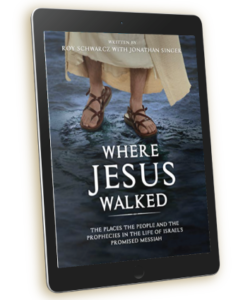Revelation 1:12-13 As we begin to consider the vision of John we bring to play the first of our 3 key rules of interpretation that we spoke of in our earlier studies: figures of speech are clearly marked either in the context or from some other part of the Bible. John says that he turned “to see the voice.” We would say: “I turned to see who was the voice speaking to me.” When he turned, he saw seven golden lamp stands.
The picture of the seven golden lamp stands has three sources in the older Testament. The picture of the candlestick or Menorah is of pure gold in the Tabernacle. (Exodus 25:31-37). We see this in the description of Solomon’s Temple where there were five candlesticks of pure gold on the right side of the holy place and five on the left 1 Kings 7:49 and from the vision of Zechariah (Zechariah 4:2). The Menorah was the only light in the holy place so that priests could see as they replenished the incense, the showbread, and the oil.
From Revelation 1:20 we know that the golden lamp stands are a picture of the Church, which is God’s provision for us as priests to see properly as we walk and serve in holy places before God. This is why it so important for us to be a part of the church. Our ministry as priests flows out of the church.
As priests we place incense on the altar, a picture of our prayers (Revelation 5:8;8:3-4) we serve the bread; a picture of ministering the bread of life to others (John 6:26 ff); and adding oil to the menorah; the oil that fueled the light is a picture of the Holy Spirit (Matthew 25:1ff). Seven is the number of completeness so the seven churches symbolize all churches. These were actual churches in real places, but are symbolic of the kinds of churches that exist through all of church history.
In the midst of the lamp stands illustrates Jesus’ promise that He would always be with His church (Matthew 28:20) He said, ” I am with you always, even to the end of the age. ” In much the same way God was with Israel in the wilderness as they journeyed to the Promised Land. He was with them as they confronted the various enemies. Likewise He promises to be in the midst of the difficult work of church discipline, the difficult work of confronting sin (Matthew 18:20). Yeshua also spoke in John 14:18-23 that He would never leave us.
John saw one like a “son of man.” This term is first used in Daniel 7:13, in which the kingdom and the power and the dominion are given by the Ancient of Days to one like a son of man. Jesus is called both the Son of Man and the Son of God. We tend to think that the title “Son of God” refers to Jesus’ deity and “Son of Man” refers to his humanity. The title Son of Man is the third most frequently used title for Jesus in the New Testament. It occurs eighty-four times, eighty-one of them in the four Gospels. In almost every case it is used by Jesus to describe himself. It was his favorite title for himself.
Some assume that it was because of humility that He selected this as a means of identifying with humanity, but in the Old Testament it not a humble one. In Daniel 7:14, the Son of Man appears in a vision of heaven presented before the throne of the “ancient of days” and “is given dominion, Glory and a kingdom, That all the peoples, nations and men of every language Might serve Him. His dominion is an everlasting dominion which will not pass away; And His kingdom is one Which will not be destroyed.”
Here the Son of Man is a heavenly being, who will descend to the earth to exercise the role of supreme judge. He is clothed with a robe that is a word in the Septuagint used to describe the robe of the High Priest (Exodus 28:4;29:5;Leviticus 16:4). Josephus also describes carefully the garments that the priests and the High Priest wore when they were serving in the Temple. They wore “a long robe reaching to the feet,” and around the breast, “higher than the elbows,” they wore a girdle that was loosely wound around the body. The girdle was embroidered with colors and flowers, with a mixture of gold interwoven (Josephus: The Antiquities of the Jews, 3.7:2, 4).
The description of the robe and the girdle of the glorified Messiah is almost exactly that of the dress of the priests and of the High Priest. The golden sash reinforces this as well, since the high priest as Josephus describes wore such a sash (cf. Exodus 28:4; Leviticus 16:4). So in the vision John saw Jesus, as the great High Priest, carrying on his priestly work, opening the way for all men to the presence of God. It was also the garment worn by princes and of kings. The same word is used for the robe of Jonathan (1 Samuel 18:4); of Saul (1 Samuel 24:5,11); the robe the risen Messiah was wearing was also the robe of royalty.
Revelation 1:14-15 – John’s description of Yeshua’s head and hair is similar to what Daniel described (Daniel 7:9), the language describes the Ancient of Days (God the Father). This deals with Messiah’s deity; He possesses the same attribute of holy knowledge and wisdom as the Father. His eyes were like a flame of fire (Revelation 2:18;19:12) speaks of His ability to see with piercing clarity everything there is to know (Matthew 10:26;Hebrews 4:13). He sees everywhere, even in the dark places and behind closed doors. His eyes search the innermost recesses of the heart. He knows all; He is omniscient and no one will be able to hide from Him nor can anyone hide anything from Him.
The reference of his feet as burnished bronzeis areference to the judgment of sinners. Kings in ancient times sat on elevated thrones, so those being judged would always be beneath the king’s feet. The feet of a king was a symbol his authority. Unlike the trumpet like sound of verse 10, His voice now was like the sound of many waters(Revelation 14:2; 19:6). This is how Ezekiel describes the voice God (Ezekiel 43:2) which further identifies Yeshua with the Father.


